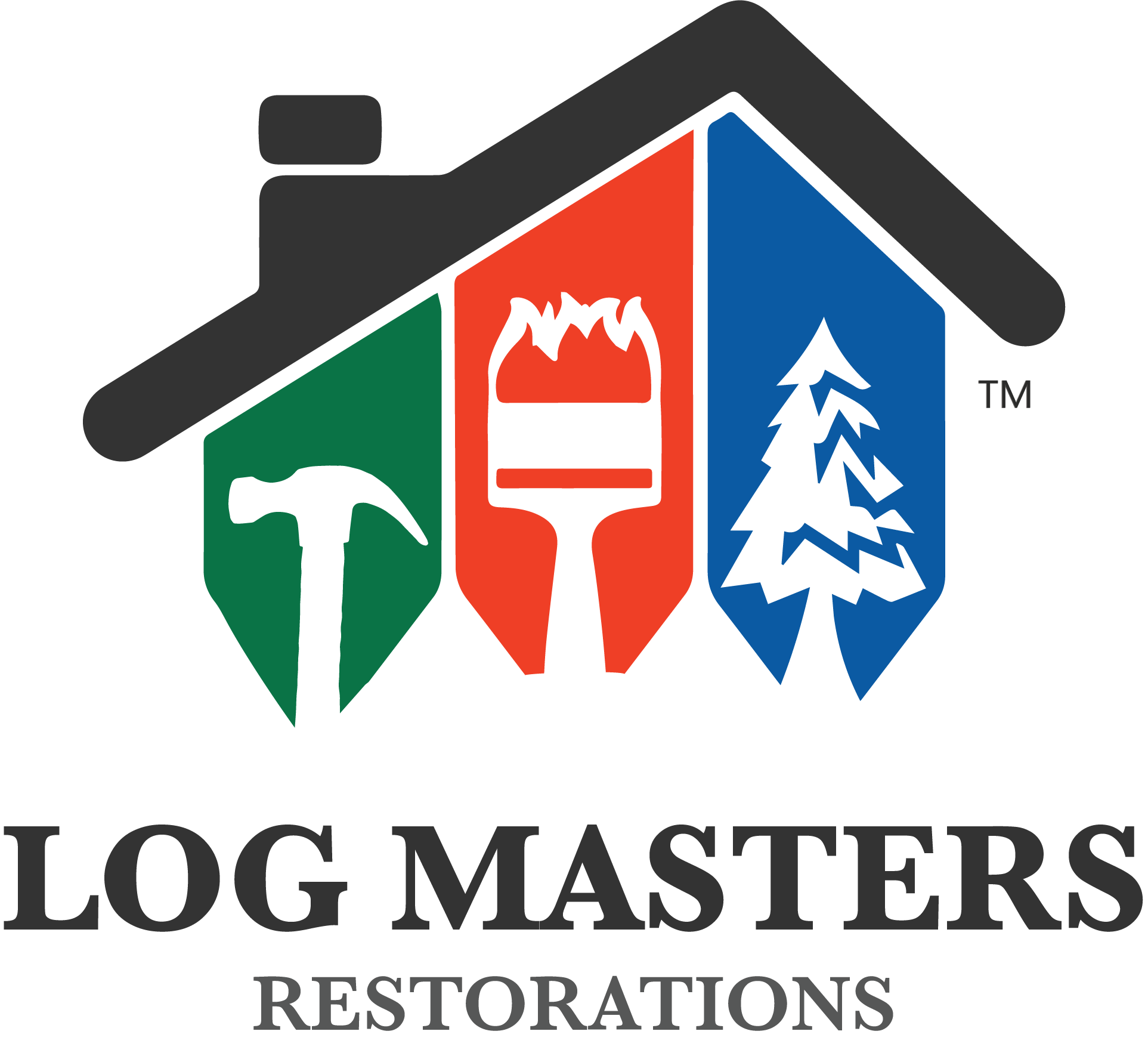If you own a log home, you already know how special it feels — warm, sturdy, and built to last. However, even the strongest log homes will shift over time. That natural movement is called settling, and while it’s normal, excessive settling can lead to cracks, sticking doors, or even structural issues.
Understanding what causes log home settling helps you identify and address minor problems before they become significant issues. Below, the Log Masters Restorations team explains the most common causes and what you can do to keep your home level, safe, and strong.
1. Foundation Issues
Your home’s foundation carries the entire weight of the structure. When it shifts, cracks, or weakens, everything above it starts to move as well. Foundation problems are one of the most common causes of excessive settling in log homes.
Small hairline cracks are usually harmless, but any crack wider than 1/16 inch warrants attention. Watch for gaps between your trim and walls, sloping floors, or staircases that seem to lean. These are often early warning signs that the foundation beneath your home has started to move.
If you suspect foundation problems, schedule a professional inspection with a foundation specialist to determine the cause. A solid foundation is the first line of defense against uneven settling and long-term structural damage.
Note: Log Masters Restorations does not perform foundation inspections or perform work on foundations. If we notice foundation issues during a log home inspection or while performing restoration work, we will recommend professionals you can consult with.
2. Wood-Destroying Insects (WDI)
Tiny pests can cause big trouble. Insects such as termites and carpenter ants eat or burrow through the wood that holds your home together. When these pests weaken the inner structure of a log, it loses the strength needed to support the weight above it. That’s when you start to see sagging walls, uneven floors, or cracked corners.
Carpenter Ants vs. Termites
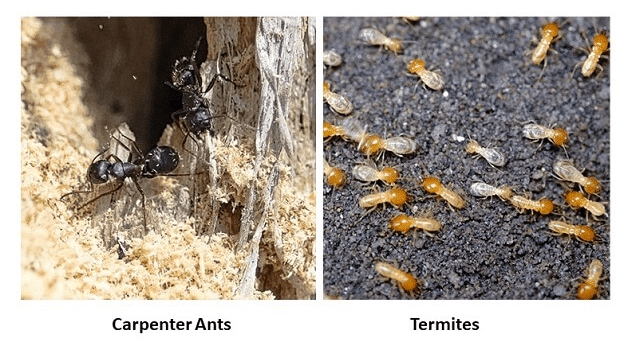
Carpenter ants dig tunnels to build nests, while termites actually consume the wood itself. Both leave behind a powdery material called frass—a mixture of sawdust and insect droppings. You may notice it accumulating around baseboards, windows, or outside walls.
If you find frass or hollow-sounding wood, call a professional exterminator immediately. Once insects move in, they don’t stop on their own. After treatment, have a log home specialist assess the damage and replace any compromised sections.
Log Masters Tip: When we inspect for settling, we always look for signs of insect activity. Catching it early prevents both structural damage and the need for costly rebuilds later.
3. Lack of UV Protection
Sunlight might not seem like a threat, but ultraviolet (UV) rays break down the outer surface of your logs just like sunburn damages skin. Without a protective stain, sunlight dries the surface, creating fine cracks that allow water to seep in.
Over time, those tiny cracks grow deeper. The wood swells when wet and shrinks as it dries, causing movement that accelerates the settling process.
A high-quality, UV-resistant stain — such as Sashco Capture — acts like sunscreen for your logs. Its elastic formula expands and contracts with the wood, preventing peeling and water intrusion. Keeping up with staining every few years is one of the easiest ways to slow down settling and protect your home from weather-related wear and tear.
4. Rotting Logs
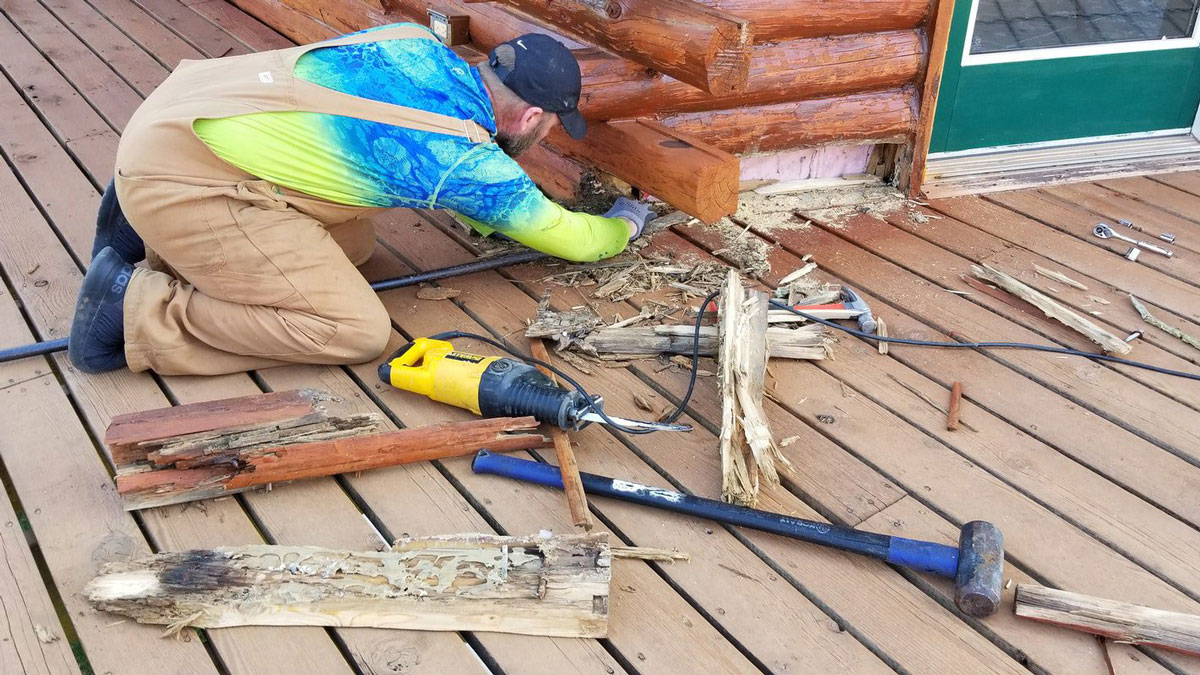
Rot is one of the most serious causes of log home settling. When moisture penetrates unsealed wood, fungi begin breaking down the fibers that give logs their strength. The wood becomes soft and spongy, losing its ability to carry weight.
Log rot usually starts at the lower courses of a wall where rain, snow, or irrigation water collects. As those lower logs decay, the structure above them shifts downward, creating visible settling and gaps.
The danger with rot is that it often begins inside the log, where it is not visible. The outside may look fine while the core crumbles away. That’s why regular inspections are essential. This is a significant difference between “Painted” logs and stained logs. Paint can give the false impression of structural integrity, but it is more likely to be a veneer.
If rot is found early, the damaged section can be replaced without tearing apart the entire wall. Log Masters Restorations specializes in precision log replacement, matching wood species, stain, and texture so the repair blends perfectly with your existing structure.
5. Log Checking
Every log home owner notices cracks, or “checks,” over time. They’re a natural part of wood drying and adjusting to humidity. Most checks are harmless, but deeper ones — especially those facing upward — can trap water.
When moisture settles inside a check, it invites rot and insect activity. Left unchecked, those weakened areas compress under pressure, causing visible settling or even wall deformation.
Routine maintenance prevents this. A simple inspection once a year can identify potential problems early. Sealing upward cracks with a flexible caulk or filler helps keep moisture out and keeps the structure solid.
Log Masters Tip: If a knife blade doesn’t slip into the crack easily, then staining/flooding the crack with stain is enough; however, if a knife blade slips into the upward-facing crack and creates a boat or hold for water to stand, then you likely need to seal it with backer rod and caulking.
6. Missing or Faulty Slip Joints and Screw Jacks
All log homes settle to some degree. Good builders anticipate that movement by installing slip joints and screw jacks that let the structure compress naturally without twisting door frames or squeezing window openings.
When these systems are missing, stuck, or installed incorrectly, the home can’t settle the way it should. Pressure builds in the wrong places. Doors and windows become difficult to open, floors tilt, and interior framing starts to warp or twist.
Slip Joints
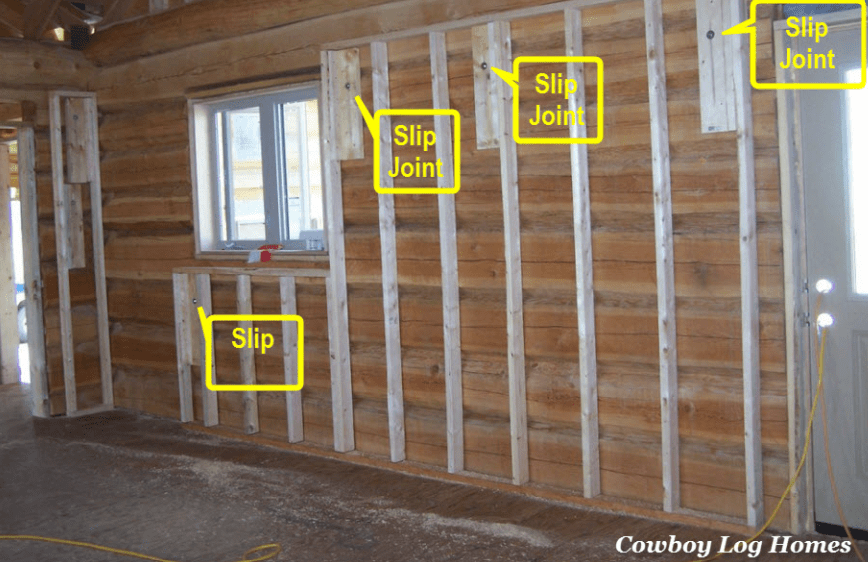
Image Credit: Cowboy Log Homes
Slip joints allow log walls to move vertically as the logs settle. They’re designed to slide smoothly so the home stays aligned. Without working slip joints, logs push against fixed components—often causing cracking, bowing, or separation.
This pressure doesn’t stop at framing. It can also transfer directly into plumbing lines and electrical conduit. As settlement forces increase, pipes may shift, crack, or develop slow leaks inside walls. Electrical wiring can become pinched, stretched, or stressed, creating potential safety hazards.
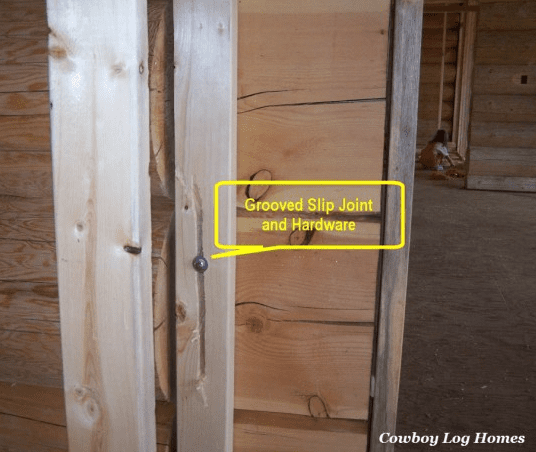
Image Credit: Cowboy Log Homes
Screw Jacks
Screw jacks are adjustable supports placed under beams or posts. Over time, they must be tuned so the house settles evenly. If they’re neglected, rusted, or seized, the home can’t move as intended. This uneven settling places stress on nearby logs, interior partitions, utilities, and finish materials.

Image Credit: Nortek Copperworks
A stuck jack can create enough downward force to crush drain lines, misalign supply lines, or strain junction boxes and electrical runs—problems that often go unnoticed until water damage or electrical issues appear.
Both slip joints and screw jacks require periodic checks and adjustments. When they’re functioning properly, they protect your structure, maintain smooth settlement, and prevent the hidden plumbing and electrical issues that can become major repairs later.
Recognizing the Signs of Log Home Settling
Spotting settling early saves you money and preserves your home’s structure. Keep an eye out for:
- Doors or windows that stick or don’t latch
- Cracks in drywall or trim that weren’t there before
- Gaps where walls meet floors or ceilings
- Leaning staircases or sagging beams
- Bowed ceilings or uneven rooflines
- Leaky plumbing
While some movement is natural, multiple signs in different parts of the house typically indicate a more significant issue.
Log Masters Insight: “Settling isn’t always bad — it’s how your log home breathes. Problems arise when that movement becomes uneven or goes unaddressed.”
How Log Masters Restorations Can Help
Our team has spent over two decades working on log homes across the country — from humid valleys to dry mountain regions. We’ve seen how different climates, foundations, and wood species react to time, weather, and neglect.
When you call Log Masters Restorations, here’s what we do:
- Inspect and Diagnose: We conduct a thorough inspection to identify settling patterns, moisture issues, and insect infestations.
- Stabilize the Structure: Using proven restoration methods, we repair damaged logs, correct alignment, and reinforce weak areas. Although we don’t work on foundations themselves, we specialize in correcting structural issues within the log system caused by natural settling.
- Protect for the Future: We apply high-quality stains, sealants, and treatments to prevent UV damage, moisture, and future movement.
Our restoration process is tailored to your specific log home — not a one-size-fits-all approach. Whether you need foundation repair coordination, log replacement, or preventative maintenance, we handle it all with craftsmanship and care.
“Our job isn’t just fixing damage — it’s helping homeowners understand their log homes so they can keep them strong for years to come.”
— The Log Masters Team
Preventing Future Settling
You can’t stop wood from moving, but you can control how much it moves. Follow these best practices to keep your home stable:
- Keep gutters and downspouts clear to direct water away from walls.
- Maintain proper grading around the foundation to prevent pooling.
- Re-stain every 3–5 years with a flexible, breathable finish.
- Check for rot, insects, and upward-facing cracks annually.
- Adjust screw jacks as part of seasonal maintenance during the first five years, and then observe after. Alternatively, you may have the builder do regular settling inspections to adjust the jacks.
These simple steps, combined with professional inspections, dramatically reduce the risk of major settling issues.
Final Thoughts
Settling is part of every log home’s natural life cycle — but that doesn’t mean you should ignore it. The key is knowing what’s normal and what’s not. Foundation movement, moisture, rot, and insects all play a role, but with the proper maintenance and professional care, your log home can stay strong and beautiful for generations.
If you’ve noticed cracks, uneven floors, or shifting doors, don’t wait. Log Masters Restorations can inspect your home, identify the cause, and create a plan to restore stability and peace of mind.
Call Log Masters today to schedule your log home inspection.
